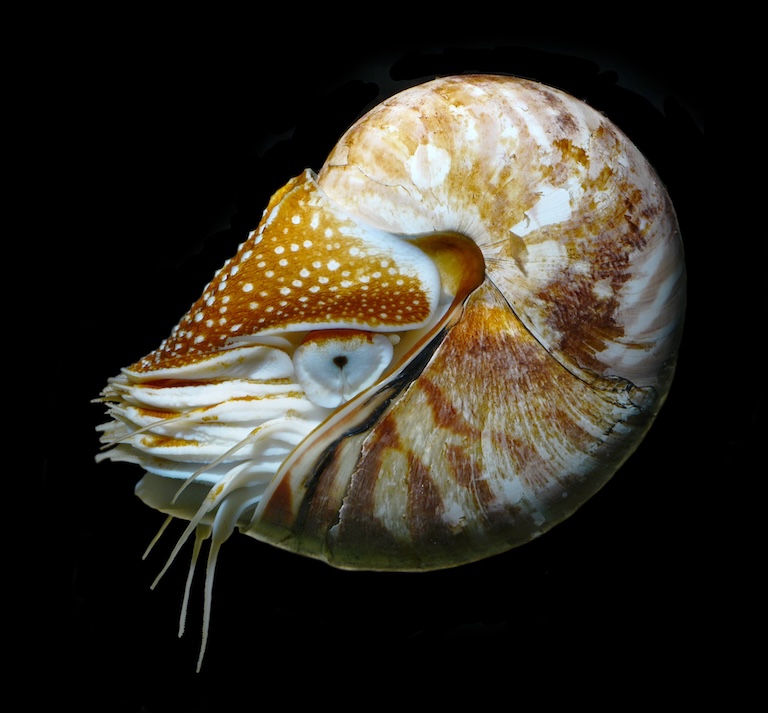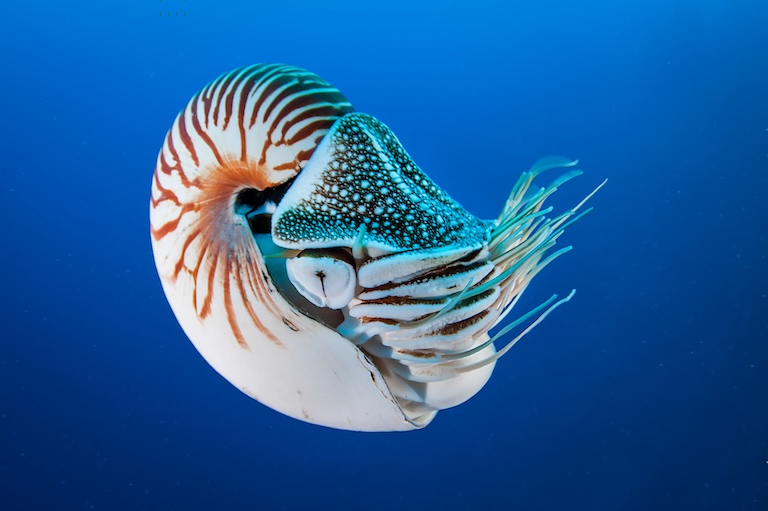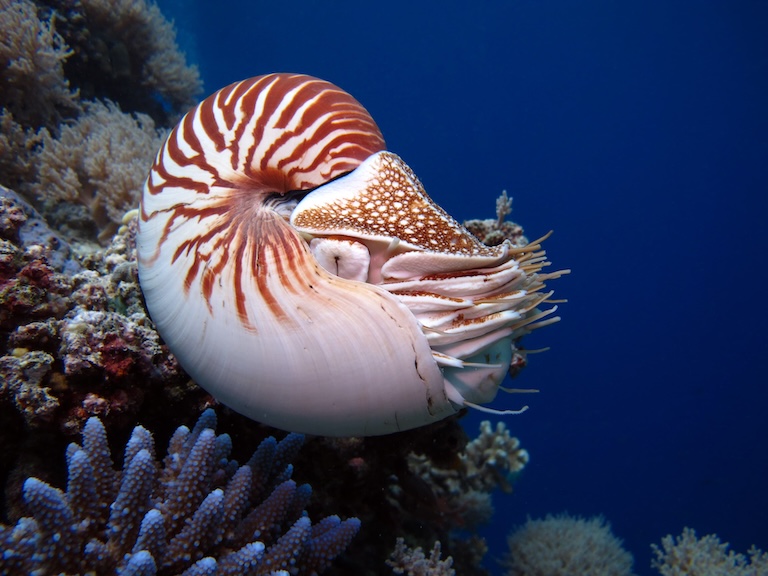Nautilus Profile
Let’s imagine you happen to be a somewhat dorky pre-teen on the rocky beaches of the Isle of Wight in the ’90s.
Of course, you’re equal parts amazed and disappointed that there are so many ammonite fossils around, yet they remain super dead and you’ll never get to see what they looked like in the flesh.
These unusually-shelled cephalopods once dominated the oceans but went the way of the dinosaurs after the 10 km-wide asteroid spoiled everything. Now, all you’re left with are their soft-bodied relatives.
Well, fear not, ignorant child! Nautiluses are basically the same thing and they’re all over the place.

Nautilus Facts Overview
| Habitat: | Marine, continental shelf and slope waters, reef |
| Location: | Widespread across the Indo-Pacific |
| Lifespan: | Up to 20 years |
| Size: | Up to 25cm (10 inches) in diameter |
| Weight: | Up to 1.3 kg |
| Colour: | Variable between species, patterened |
| Diet: | Fish, crabs, and lobsters |
| Predators: | Sharks, powerful bony fish, turtles, octopuses |
| Top Speed: | Slow |
| No. of Species: | Probably around 11 |
| Conservation Status: | Mostly Data Deficient, some Near Threatened (IUCN) |
Nautiluses are a fascinating, yet barely-understood bunch of cephalopods that represent an ancient past; one that most life forms didn’t survive through, and wouldn’t remember very well if they did. But the nautiluses remember.
Despite having a relatively simple brain, they show rudimentary memory capabilities which may or may not have helped them survive through a disaster that wiped out their squiddy doppelgangers.
Interesting Nautilus Facts
1. They’re not ammonites
Okay, things were said, promises were made, and some things need to be clarified…
While superficially like ammonites, it’s likely nautiluses differ quite a bit on the old family tree when compared with the ancient beach spirals. Ammonites were probably a branch of cuttlefish and squid relatives – members of the Coleoid subclass.
The ancestors of all the remaining Coleoids once had shells, but all we’ve got left now are the squishy versions.
However, Nautiloids are incredible in their own right, as they remain the product of around 500 million years of epic tentacled predators, and the oldest lineage of cephalopods; which makes them far superior to the ammonites who changed quite rapidly to extinction only 66 million years ago.
Technically, they’re not all over the place, either. They’re only found in the ocean, and only across the Indo-Pacific at that.
But there are lots more of them than there are ammonites, and they were once just as grand!

2. They used to be massive
A lot has happened in the ocean in 500 million years, yet nautiluses have witnessed it all. They began life as dominant predators, despite their derpy flotation-based locomotion, and grew to proportions that are truly frightening.
Just like the largest ammonites, some species of nautiluses would have once been more than 1.5 metres across, more than large enough to kill and eat a cow, if cows had existed at the time and also lived in the ocean.
And if you include all Nautiloids, you have to include the extra-long ones that existed before they chose to coil their shells. The Endoceras nautiloids were patrolling the Ordovician waters around 420 million years ago, appropriately looking a lot like a six-metre spliff with tentacles.
Today, an Indonesian species known as the chambered nautilus holds the record at a lacklustre 25 cm in diameter. Most other species grow no more than 20 cm across. 1
3. There are fuzzy ones
Nautiluses can be grouped into two loose categories. There are the animals in the Nautilus genus, which could perhaps be called the true nautiluses. These tend to stay above 700 metres and float around scavenging dust and predating upon small animals.
Then there is the Allonautilus genus, which currently contains only two species, but given the sloppy taxonomy in this family, will likely receive more in the future. These guys are not well understood, but perhaps descended from the Nautilus species and spend time in really deep waters.
At least one of these is called the fuzzy nautilus, or sometimes the crusty nautilus because it’s kinda gross.
These rare and relatively unknown guys are covered in a shaggy coat that resembles slimy hair. This is the same hair that can be seen in various clams, some land snails, and some mussels, though not the same as the stringy fixing fibres mussels use to attach themselves to rocks. 2
4. They’re camouflaged
As the only shelled cephalopod left, Nautiluses have a lot of say in how they look. This shell is pressure-resistant, coiled, and filled with air chambers which can be adjusted to increase or decrease the buoyancy of the animal in the water column.
Still, this is a slow process, so not ideal for escaping predation, and instead, camouflage does a lot of the heavy lifting when it comes to protecting Nautiluses.
While they look pretty glaring and vibrant out of the water, the stripes and colours on these incredible animals make them very hard to spot when among dappled sunlight and algae.
The shell is darker when seen from above and lighter underneath: a classic form of countershading.
And when an animal is supremely camouflaged, it rarely needs to develop much brain power.

5. They’re simple
Cephalopods are well known for having some of the most incredible eyes in the animal kingdom. Evolved independently of the mammalian eye, these structures are often in many ways more advanced.
The giant squid has the largest eye on earth, and the octopus can contract its eyeball to focus on different wavelengths of light at will.
The nautilus eye doesn’t do any of this and has no lens or even cornea. It’s a very simple eye that is used to tell what time it is. Hunting is therefore done mostly through taste.
The octopus brain is also well known for being complex and decentralised, but the nautilus pales in comparison here, too. A simple brain with fewer lobes and neurons than the coleoids doesn’t give the animal a lot of diversity in its skill set, but does apparently allow it to remember where the food is. 3
6. But they do think (a bit)
Nautiluses are a good example of why behaviourists are relevant. Researchers dissecting the nautilus brain estimated that it’s about as much use as a paperweight for thinking, but studies into their ability to lean contradict what we can currently extrapolate from just looking at it.
A day in the life of a Nautilus involves a migration up and down, from the protection of the dark to the food larder in the shallows and back again. But apparently, this is enough pressure to create a need for memory, and nautiluses have it.
Studies show that they can learn and remember things, despite being absent of the vertical lobe complex that we so-called big brains assumed was responsible for such characteristics. This not only shows us that they’re smarter than we expected but also that we’re dumber.
Nautiluses still might not be as smart as ammonites were, but if ammonites were so smart, how come they’re dead? 4
7. They’re mostly male
Interestingly, from the samples brought up by the fishing industry, nautiluses are mostly male.
This suggests a naturally uneven sex ratio (and if not, certainly creates one) but it could be explained by differences in behaviour and distribution between the sexes. Records show that 70% – 80% of captured nautiluses are male.
NautilusFact-File Summary
Scientific Classification
| Kingdom: | Animalia |
| Phylum: | Mollusca |
| Class: | Cephalopoda |
| Order: | Nautilida |
| Family: | Nautilidae |
Fact Sources & References
- Emma Haskin (2021), “Fossil reveals giant underwater killing machine that once called outback Australia home”, ABC Australia.
- Gregory Barord (2017), “FUZZY NAUTILUS trying hard to get our bait”, YouTube.
- Robyn J Crook (2008), “A role for nautilus in studies of the evolution of brain and behavior”, NIH.
- Allison Runck (2018), “Chambered Nautilus”, Australian Museum.
